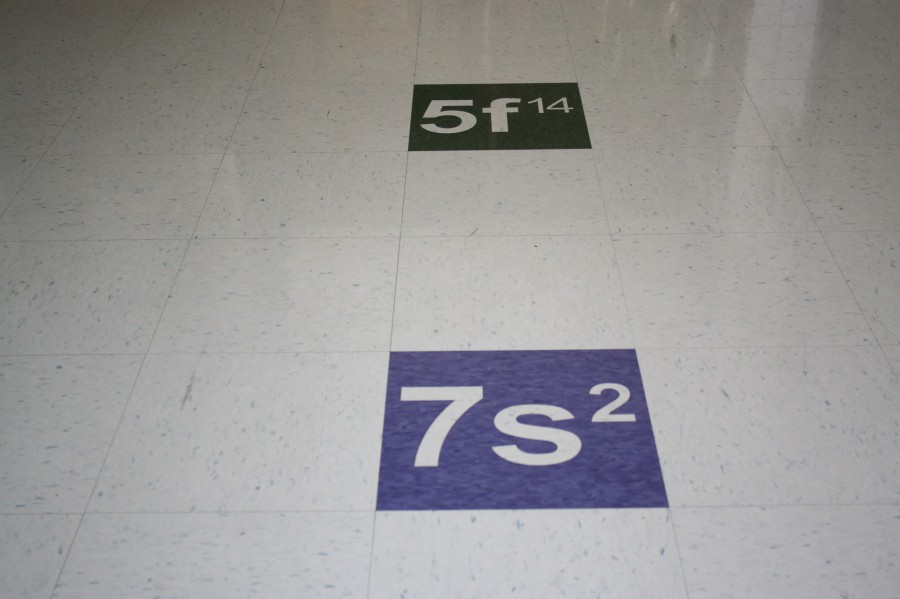On Dec. 30, Elements 113, 115, 117 and 118 were officially recognized by the International Union of Pure and Applied Chemistry (IUPAC), the US-based world authority on chemistry. This recognition completes the seventh row of the Periodic Table, but at the same time also makes tens of thousands of textbooks obsolete.
“The elements fit just fine in the same order, but will make the table out of date for schools which will make me buy new textbooks so they’re up to date,” science teacher Colleen O’Toole said.
In 2013, Swedish scientists confirmed the existence of the Russian-discovered Ununpentium (atomic number 115). As they described it, the element was produced by a shooting a beam of Calcium, which has 20 protons, into a thin film of Americium, which has 95 protons. For less than a second, the new element had 115 protons.
“The new chemical changes could be highly radioactive and decay faster,” O’Toole said.
IUPAC has started the process to formalize the names and symbols for these new elements. They have been given temporary names; Ununtrium, (Uut or element 113), Ununpentium (Uup, element 115), Ununseptium (Uus, element 117), and Ununoctium (Uuo, element 118).
“Some of the elements might have been exploded from star stuff that could have not been detected on earth. Might be even more than what we thought,” O’Toole said.
This new update follows the 2011 update when elements 114 Flerovium and 116 Livermorium were added. Now that the elements have been validated, permanent names have to be selected. IUPAC dictates that any new elements can be named after a mineral, a place, a myth or a scientist.
“[The new elements] should be named after scientists. I’d like to see Einsteinium, O’Tooleium or Degrassetysonium,” O’Toole said.



![Gazing up from the stage, junior Joseph McCurdy who played Peter Pan in the school play, Lost Girl, sits next to senior Juliana Rogers, who plays Wendy Darling, during a theater rehearsal. McCurdy’s passion for theater began when he observed a West High production in middle school. “I've been in the high school theater program since I was a freshman. I've always loved theater, but [what prompted me to join] was [when] I went to see [a performance here] when I was in middle school, and it was super cool,” McCurdy said.](https://pwestpathfinder.com/wp-content/uploads/2025/11/IMG_6535-1200x798.jpeg)

![Standing tall, stacked in a precise formation, the cheer team strikes a signature pose during halftime on Sept. 12 at the varsity football game. Nearly a month after this performance, the cheer team performed at the Missouri Cheerleading Coaches Association (MCCA) regional competition on Oct. 4, 2025. “We've all come [to] work together a lot more,” sophomore Elyssa Philippi said. “We're a lot closer than we were [earlier in the season] and going to state has made us closer [in] trying to work with each other, learn [new] skills and make our team better.”](https://pwestpathfinder.com/wp-content/uploads/2025/11/DSC5139-1.jpg)
![Handing out candy to excited trunk-or-treaters, President of the United Nations Children’s Fund club and junior Sara Ashok represents that group. Ashok was eager to participate in this event for multiple reasons. “I really wanted to be a part of the event because I get to help create memories for kids and spend time with my friends, spreading the things [I'm passionate about],” Ashok said.](https://pwestpathfinder.com/wp-content/uploads/2025/11/DSC_8648-1-1200x800.jpg)

![Smiling in a sea of Longhorns, Fox 2 reporter Ty Hawkins joins junior Darren Young during the morning Oct. 3 pep rally. The last time West was featured in this segment was 2011. “[I hope people see this and think] if you come to [Parkway] West, you will have the time of your life because there are so many fun activities to do that make it feel like you belong here. I was surprised so many people attended, but it was a lot of fun,” Young said.](https://pwestpathfinder.com/wp-content/uploads/2025/10/Edited2-1200x798.jpg)
![West High seniors and families listen as a representative of The Scholarship Foundation of St. Louis, Teresa Steinkamp, leads a Free Application for Federal Student Aid (FAFSA) workshop. This session, held in the library, provided guidance on financial aid, scholarships and student loan options. “This event is very beneficial for any seniors who are applying to or considering applying to colleges after high school [because] the cost of college is on the rise for seniors and parents,” college and career counselor Chris Lorenz said.](https://pwestpathfinder.com/wp-content/uploads/2025/09/DSC_4478-1200x778.jpg)
![Senior Kamori Berry walks across the field during halftime at the Homecoming football game on Sept. 12. During the pep assembly earlier that day, she was pronounced Homecoming Queen. “I thought it was nice that the crowd [started] cheering right away. I know [my friends] were really excited for me, and my family was happy because typically non-white people don't win,” Berry said.](https://pwestpathfinder.com/wp-content/uploads/2025/09/DSC7046-Enhanced-NR-1200x798.jpg)


